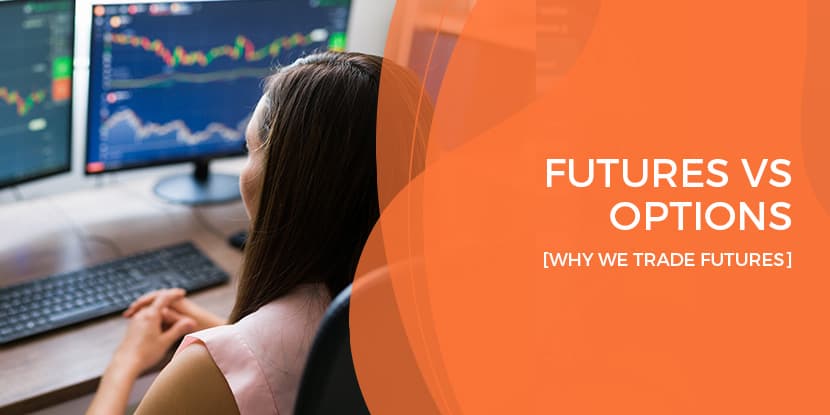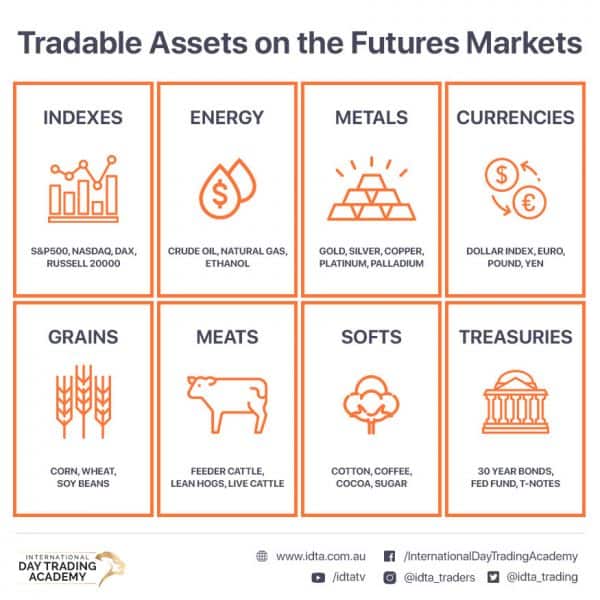
Futures vs Options
At first glance, the question of Futures vs Options may not appear obvious as they are both derivative products that derive their value from an underlying asset. However there are also significant differences and we believe that there are some key benefits to Futures vs Options.
Difference Between Futures and Options
The difference between futures and options may not be clear at first sight. Both of these products are derivatives.
What this means is that Futures and Options contracts derive their value from an underlying asset, e.g. a stock or stock index.
What are Futures?
Futures or a Futures contract is an agreement between a buyer and a seller to either sell or buy back an asset at a future date. Note that a Futures trader does not need to wait until the end of the contract to exit the trade. This is why we are able to Day Trade the Futures markets.
What are Options?
Options or a Options contract is much like Futures where by they are an agreement between a buyer and a seller to either sell or buy back an asset at a future date. The difference between Futures and Options is that with Options, the buyer/seller has the right but not the obligation to do so.
Futures Trading vs Options: Which One is Better?
Simply put, even though Options, Futures and other derivatives share many similarities, the advantages of Futures are well-documented. The benefits of Futures are diverse, ranging from its associated liquidity, fixed upfront trading costs, and ability to hedge against volatility, among other appealing characteristics.
Highly liquid
The Futures markets are some of the most liquid markets in the world. Billions of dollars are traded on some of the larger Futures markets on a daily basis. This means that there is no shortage of buyers and sellers available and taking a trade is extremely quick, there is no extended waiting for an order to execute as is the potential with stocks.
A futures trader has the confidence in knowing that their order can be executed instantly, the same applies for exiting trades. Options, depending on the underlying asset, may have much less volume. What this means is, the trader may need to wait for their trade to be filled, both entering and exiting. If the Option is far away from either the strike price or the expiry date will be less popular for trading and therefore will have a low liquidity.
Futures may be easier to understand
Options trading uses terms like, Put, Call, Selling a Call, Intrinsic value, Time decay, Premium… even if you know what those words mean, the concept behind them can be quite confusing.
Options create another level of complexity in that there are more than two types of trades you can place (rather than just buy or sell) and more ways to value. Both the upfront costs and asset value are well known when trading Futures as are the margin requirements as those rarely change. There are more inputs when pricing Options, and the difference between simply placing a Put or Call trade and ‘Selling a Call’ are vast.
Transparent costs
The Futures markets are perhaps the most well regulated markets available. Trading costs (margin) are relatively stable compared to Options premiums which are slightly more fluctuating with volatility. Because of this pricing is also far easier to understand for Futures as opposed to Options.
No time decay
Options are referred to as ‘wasting assets’ because as time passes the value of the asset decreases. This is not the case with Futures, the only thing that affects asset value is the market price itself. The decrease in value observed with Options is referred to as ‘time decay‘ and influenced particularly as the expiration date of the contract nears.
Trading Options vs Futures adds another element of risk because of this, it is important that an Options trader closely monitors the affect of time decay as it can seriously effect the eventual profit/loss of the trade.
More Diversity
The Futures markets are the most diverse in the world and give traders access to many different asset classes that can’t be accessed by other trading products. With Futures you a trader is able to trade commodities, Indexes, and currencies. Some of the major asset classes that Futures traders have the ability to trade are:
Commodities: Oil, Gold, Silver, Wheat, Natural Gas, Corn, Soy Beans, Meats, Cotton
Indexes: S&P 500, NASDAQ, DAX
Currency Futures: 6A (USD/AUD), 6B (USD/GBP), 6E (USD/EUR), BTC1 (USD/BTC)

More accessible for Day Trading (no PDT Rule)
Options trading falls under the Pattern Day Trader (PDT) rule, Futures do not. The PDT rule states that any trader placing four or more trades within a five business day period is deemed as a Pattern Day Trader.
A Pattern Day Trader under the PDT rule is required to trade an account no smaller than 25,000 in order to day trade. Futures are one of the few trading products that do not fall under this rule meaning that a trader can trade an account that is smaller than $25,000.
With the availability of E Mini Futures trading Futures is more accessible for those trading smaller accounts.
The PDT rule limits a trader to placing no more than 3 intra-day trades per week. In the world of Day Trading this means that you will be sitting on the sidelines unable to trade more often than not. It is difficult to be consistent when you’re unable to trade regularly and it is difficult to grow an account with such limited trading.
There is one way to trade Options and not be subject to the PDT rule, however it involves other limitations. An Options trader can avoid the PDT rule by trading a “cash” account. Trading a cash account will allow a trader to place an unlimited number of intra-day trades per session should they have the funds available.
When a trade is exited on a cash account the funds will take 3 days to settle, which means a trader has their funds tied up and unable to trade in that period.
Because the account is a small one, tying up funds has a similar problem as with the PDT rule where the funds are simply not made available enough to trade regularly.
For those without access to the funds required, or those who simply don’t want to start trading with an account that size, you can avoid this rule.
Futures trading has no PDT rule, a trader simply needs to have enough funds available to execute trades. Given the existence of Mini and Micro Futures markets traders are able to start out with a day trading account that is considerably smaller than what is needed for Options traders.
Options vs Futures: When you might want to choose Options
The Futures markets are not as suited to trading stocks as Options are. You can trade stocks via a Futures exchange, however that market is more niche and therefore not as liquid.
But with so many different asset classes available on the Futures markets (including the indices that the stocks are listed on), there is more than enough choice for asset classes to trade.
The maximum risk for Options is limited to the cost of premium to enter a trade. When trading Futures both the profit and loss are unlimited.
If you choose to trade Futures but ignore the use of a stop loss and correct risk management techniques you will be more at risk than an Options trader doing the same. This is why we recommend that everyone uses stop loss orders on their active trades when trading Futures.
Futures vs Options: The Bottom Line
Futures trading offers a great opportunity to make higher returns via trading on margin as a leveraged product. However it is extremely important to apply proper risk management techniques to limit the size of losses given that losses are also leveraged.
There are pros and cons to trading Futures vs Options, however the accessibility and fairness in pricing along with the diversity and overall less complicated functionality makes Futures the market that we choose to trade.
If you want to learn more about trading Futures and why we choose to trade them over any other form of trading, join us for one of our FREE online trading courses.
Completed the Essential trading courses? Take a step further with one of our advanced futures day trading courses today.

